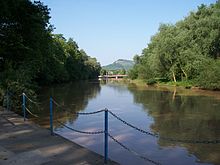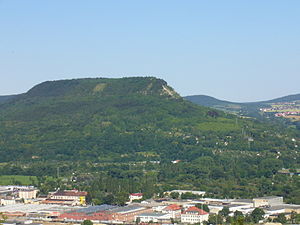Jenzig
| Jenzig | ||
|---|---|---|
| height | 385.3 m above sea level NHN | |
| location | near Jena , Thuringia ( Germany ) | |
| Mountains | Eastern Jena plaice | |
| Dominance | 1.78 km → Hausberg | |
| Notch height | 97 m ↓ pass of the B7 near Kleinlöbichau | |
| Coordinates | 50 ° 56 '28 " N , 11 ° 38' 7" E | |
|
|
||
| rock | Shell limestone | |
| particularities | striking mountain of the Saale valley | |

The Jenzig is a distinctive shell limestone mountain in Jena .
Geography and location
The Jenzig is 385.3 m above sea level. NHN is one of the highest mountains in the area and is located northeast of the city center. Its distinctive shape ("Jenzignase") makes it one of the seven wonders of Jena .
The Jenzighaus stands on the hilltop, a popular excursion destination with an excellent view of the city.
The Jenzig forms the southwestern end of a semicircular ridge, the horseshoe . This wooded plateau runs from Jenzig to the east, over an arch approximately at the same height further north and then back to the west, where the old Gleißberg and the Kunitzburg form the other end. A small side valley of the Saale valley as well as the villages and Jena districts Kunitz and Laasan are located “in” the horseshoe .
Emergence
The mountain is actually a dome-like and elongated formation of the Saale valley slope, an eroded plateau. The river and its associated streams have worked their way into the limestone of the area, leaving behind the typical landscape of the Middle Saale valley .
Prehistoric and early historical fortifications
According to archaeological finds, the Jenzig carried a fortified hilltop settlement in the Urnfield Period (approx. 1300 BC to 800 BC), which offered protection to the surrounding population. It was examined by Friedrich Klopfleisch in several excavation campaigns between 1856 and 1891 . In 1936, a hoard found during quarrying found its way into the prehistoric and early historical collection of the University of Jena . The complex, which weighs almost 3.5 kg, consists of 28 bronze objects such as neck and arm rings, spirals, a decorative disk, two sickles, a knife, an ax and a spiral plate fibula. It testifies to the religious sacrificial practices of the people in the late Bronze Age.
Fortified prehistoric hill settlements, which were often used at the same time as the Jenzig, are also known in the vicinity from the Old Gleisberg near Bürgel , the Johannisberg near Jena-Lobeda and the Dohlenstein near Kahla .
The name Jenzig is derived from the Slavic "Jancko gora", which means Jena mountain.
The mountain was first mentioned as "montem genzege" in a document by Friedrich I. Barbarossa from 1158. The Gleisberg is also mentioned in it. Since all objects named as imperial property in this document - except for Jenzig and Gleisberg - were named as castles or (fortified) farms, one can probably assume that there were castles or fortified farms on Jenzig and the neighboring Gleisberg at that time . With the aforementioned document, these objects were added to the Staufer imperial territory of Pleißenland near Altenburg .
The slopes of the Jenzig had been an important wine region in Jena since the 12th century, before they were abandoned in the 19th century. For several years now, a group of hobby winemakers has been reviving the tradition of viticulture at Jenzig.
Trivia
The Jena Neofolk group Forseti named their first album after the mountain.
In March 2010, a camel born during a guest performance by the "Eros" circus in Jena, whose dam belongs to the circus animal population, was named "Jenzig".
The 2090 m high Jenzigberg , located in North Victoria Land in the Antarctic, was named after the Jenzig in 1988 by Klaus Duphorn ( University of Kiel ).
The Jenzig-Verlag , a company based in Golmsdorf (Saale-Holzland-Kreis) in Jena regional publishing, has named after the mountain.
In addition, it is listed indirectly in the Seven Wonders of Jena .
Web links
Individual evidence
- ↑ Map services of the Federal Agency for Nature Conservation ( information )
- ↑ Linke, Franz and Bühner, Peter: Jena viticulture in the past and present - series of publications by the Jena Municipal Museums
- ^ Walter Schlesinger , edited by Thomas Lang: Contributions to the history of the city of Glauchau, editor: Enno Bünz, Thelem Verlag, Dresden 2010, comments on Gleisberg and Jenzig near Jena, p. 44
- ↑ http://www.jenzig-gesellschaft.de/jenzig/node/126

